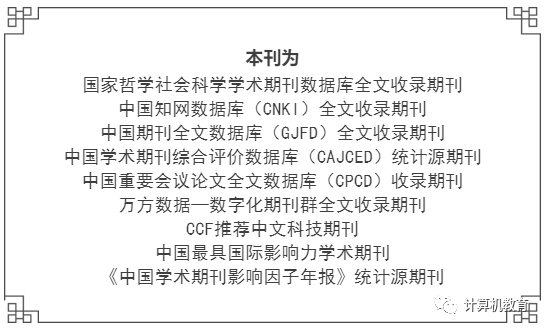0 Introduction
Linux is a very important course in computer science, extending and upgrading the operating system course, and serving as the foundation and support for courses in artificial intelligence, big data applications, embedded development, computer network management, virtual reality, and more [1]. The importance of the Linux course is also reflected in its dominance in open source software and network services [2]. Therefore, improving the teaching level of the Linux course and the learning outcomes of students is beneficial for promoting the learning of related disciplines.
The Linux course in the context of new engineering education is a practical course that requires strong hands-on abilities. It needs to verify, think about, and expand knowledge through practical operations based on understanding the concepts, thereby enhancing students’ hands-on abilities to manage Linux systems, their business capabilities to analyze and solve engineering problems, and their research abilities to innovate. Therefore, it is necessary to reform and innovate the teaching model of the Linux course, truly enabling students to apply what they have learned and understand why they are learning and what use it has. An important issue that needs to be addressed in the teaching process is personalized instruction, as different students have varying learning abilities and foundations. How to analyze students’ learning situations and behaviors to identify factors affecting their learning and plan personalized learning schemes has become an important research direction [3-6].
1 Problems in Linux Course Teaching
Currently, there are several issues in the teaching practice of the Linux course.
(1) Difficulty for beginners. Students have little exposure to the Linux operating system, and due to the significant differences between Linux and other operating systems like Windows and mobile OS, along with various versions, transitioning to Linux requires changes in operating habits and usage methods, which presents a certain level of difficulty for beginners.
(2) Knowledge points are scattered and numerous, making them easy to forget, and students’ motivation for self-directed learning is low. Learning knowledge points requires attention to details, focus on relationships, and constant reflection, but some students are unwilling to engage in deep learning and thinking.
(3) Students read a lot but practice little. The Linux course requires a significant amount of time spent on hands-on practice and repeated exercises, such as vi operations, shell commands, etc. Without effective supervision, most students are reluctant to invest large amounts of time in hands-on practice.
(4) Assessment methods mainly consist of assignments, experiments, and exams, and the results are merely evaluations of learning outcomes. There is insufficient use of quantitative assessment data for in-depth analysis and integration with learning data to provide each student with a learning profile and recommendations while also supervising their implementation.
(5) Lack of personalized teaching. Due to varying knowledge bases and learning abilities among students, applying the same teaching methods and pace to all students often does not yield optimal teaching results.
(6) Lack of integration with practical applications. Knowledge is meant to be applied; after learning course content, students often feel confused and do not understand the usefulness of what they have learned. Teaching knowledge points must be integrated with engineering problems to enhance the effectiveness of teaching and make it more engaging for students, broadening their perspectives.
2 Linux Course Teaching Design
2.1 Teaching Design Objectives
The design of the Linux course mainly revolves around three levels of objectives.
The first level of objectives is to meet the teaching tasks of the course. The task of the Linux course at Jilin University is “one teaching, two cultivations.” The “one teaching” refers to imparting the basic theories, foundational knowledge, and fundamental skills of the Linux operating system. The “two cultivations” refer to training students’ professional capabilities, basic engineering qualities, and good comprehensive qualities through practice and innovation training, as well as developing their preliminary abilities to analyze and solve complex engineering problems by considering economic, environmental, social, legal, and other comprehensive factors.
The second level of objectives is to achieve classroom goals. Teaching includes both teaching and learning aspects; it is not a one-sided process of imparting or receiving information. Thus, ensuring smooth interaction between teaching and learning is the first goal of Linux classroom teaching. The second goal is to construct a closed loop of “teaching-practice-assessment-teaching,” allowing knowledge to be understood, absorbed, and systematized through continuous flow. The third goal is to foster students’ emotional connection to the discipline in the classroom and convey correct values.
The third level of objectives is the quality objectives for students. The outcomes of teaching should be reflected in the improvement of students’ qualities. In the well-known OBE (Outcomes-based Education) method, emphasis is placed on student-centeredness and quality orientation. The quality objectives for students in the Linux course mainly include two aspects: knowledge and ability, meaning that students should master all knowledge and skills, processes, and methods required in the Linux course while also possessing the two qualities and abilities required in the teaching tasks.
2.2 Teaching Design Framework
The design of the Linux course is a feedback-based continuous improvement teaching system centered on students’ acquisition of knowledge, skills, and values, driven by engineering practice, supervised and assessed, and supported by new IT technologies and cognitive science theories, as shown in Figure 1.
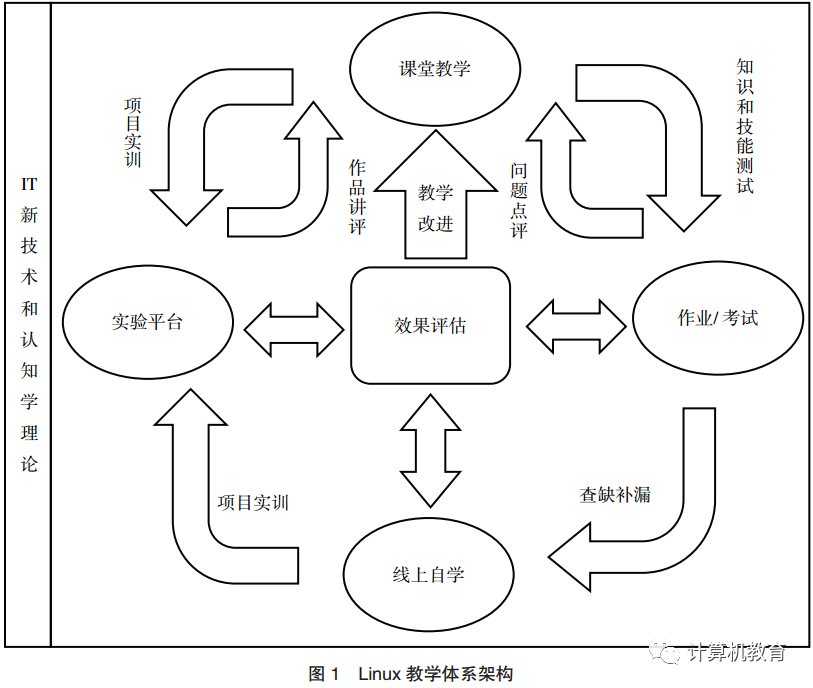
The Linux course belongs to the field of computer science, which naturally has a foundation for adopting new IT technologies. By utilizing new IT technologies such as AR, VR, cloud computing, big data, and AI, the abstract knowledge can be visualized, assignments and exams can be digitized, experiments can be cloud-based, data collection can be automated, and data analysis can be intelligent, promoting the continuous development and improvement of Linux course teaching.
2.3 Key Content of Teaching Design
2.3.1 Diversification of Teaching Models
The first issue to address in the teaching design of the Linux course is the problem of teaching and learning, specifically the design of teachers’ teaching methods and the constraints of students’ learning modes. Teachers’ teaching is an actively implemented process that should not be rigid or fixed; it should change with time and environment, representing a continuously developing and improving process.
In the context of new engineering education, the teaching model for Linux should be diversified and hierarchical.
(1) Strengthen the integration of the course with engineering problems, using engineering problems to drive and validate the learned Linux knowledge and skills. Activate students’ subject awareness and stimulate their initiative, enthusiasm, and creativity.
(2) Provide students with multiple channels for acquiring knowledge and various ways to display knowledge. Break through the traditional two knowledge channels of teachers and textbooks in Linux teaching, and provide more ways to acquire knowledge based on the internet. Move beyond blackboard and PPT presentations, incorporating audio, video, animation, 3D, VR, AR, and various media technologies.
(3) Eliminate communication barriers between teachers and students, using communication outcomes to correct teaching directions. Unlike primary and secondary education, universities have less face-to-face communication; thus, social software, video conferencing, BBS, etc., can be introduced as auxiliary communication tools, employing various communication methods like one-on-one and one-to-many.
(4) Adopt a “commonality + individuality” teaching approach. The best teaching method would be completely personalized teaching, with a tailored teaching pace; however, this is not feasible in a university teaching system. Therefore, common teaching should serve as the foundation, while personalized teaching acts as a supplement.
(5) Emphasize moral education alongside technical skills. Break the teaching model that focuses solely on knowledge transmission in engineering education, integrating correct values into teaching activities to ensure that “knowledge is directed toward goodness.”
(6) Utilize scientific supervision of learning. Based on years of teaching experience and relevant scientific research [7-10], most students’ learning is not entirely autonomous, disciplined, or planned; thus, scientific methods should be employed to constrain and supervise students’ learning.
2.3.2 Digitalization of Assessment Methods
The assessment of the Linux course includes knowledge retention assessments, knowledge application assessments, and engineering practice assessments. These assessments should transition from traditional manual assessment methods to electronic, digital, automated, and intelligent approaches.
(1) Electronic assignments. Adopt digital and electronic formats for assignments, using a question bank as a foundation to support various question types such as multiple choice, fill-in-the-blank, true/false, and open-ended questions, meeting the requirements for assignment distribution by teachers and self-practice by students.
(2) Platform-based experiments. Establish a dedicated cloud experimental platform to achieve more effective experimental management, providing a customizable personal experimental environment that is available anytime and anywhere, with automated assessment of experimental results.
(3) Automated exams. As an essential means of evaluating learning outcomes, exams are indispensable. Automated question generation based on rules and automatic answer matching can enhance exam efficiency.
(4) Intelligent data analysis. The electronic assignments, platform-based experiments, and automated exams lay the groundwork for data analysis. By establishing a mapping between questions and knowledge, collecting data from assignments, experiments, and exams, and applying data analysis and mining techniques, a learning outcome profile can be established for each student.
2.3.3 Integration of Cognitive Science
Although the human learning process is a complex neuronal change process, it also follows certain rules, which is the essence of cognitive science. Integrating cognitive science into the teaching process can help improve students’ learning efficiency.
(1) Adjust teaching forms according to cognitive principles. Teaching that aligns with cognitive principles can activate student thinking and continuously enhance their creative thinking abilities.
(2) Enhance knowledge retention. One key factor for improving learning efficiency is memory. By applying the principles of cognitive science, teaching, assignments, and exams can be arranged to gradually solidify students’ short-term memories.
(3) Cultivate students’ image thinking, intuitive thinking, and dialectical thinking. In teaching the Linux course, two difficulties hinder students’ absorption of knowledge: the contradiction between the super-realistic and abstract teaching content and the formalized teaching methods, and the contradiction between the knowledge discovery process and the textbook knowledge deduction methods. It is necessary to reasonably set teaching content and methods according to cognitive science principles to cultivate students’ ability to visualize knowledge points and summarize knowledge systems.
3 Implementation of the Linux Course
3.1 Combining Online and Offline Learning
Offline interactions are often one-time teaching sessions; once the lecture ends, it is not repeated. Omissions or forgetfulness can lead to gaps in knowledge mastery. Recording online videos and creating animations, 3D, and VR demonstrations of knowledge points allows students to view the teacher’s explanations anytime and anywhere, filling in gaps in their understanding.
These online resources are not directly used for online teaching but serve as supplements to offline teaching, providing repeatable, customizable teaching resources and real-time learning feedback for offline instruction.
3.2 Combining Teaching Processes with Cognitive Principles
The human learning process follows certain scientific principles. Representative theories include Gestalt’s theory of insight, Bruner’s theory of cognitive discovery, Ausubel’s theory of cognitive assimilation, and Gagne’s cumulative learning theory [7-10]. These theories share some common points.
(1) Intuitive cognition is crucial for learning.
(2) Learning is the transfer of knowledge. Ausubel divides learning into rote learning and meaningful learning. Rote learning is learning through repetition without understanding, while meaningful learning constructs a new knowledge structure based on existing cognitive foundations. Meaningful learning requires two conditions: students’ willingness to learn and a logical connection between new and old knowledge. The teaching process should help students establish this logical connection and form new knowledge systems.
(3) Learning requires setting goals.
(4) Learning requires supervision, which can be self-supervision, teacher supervision, or institutional supervision.
Based on the above conclusions, improvements should be made to the teaching methods in the Linux course.
(1) Make learning enjoyable. Introduce fun mini-games on the Linux operating system, such as puzzle games, to increase students’ familiarity with the Linux OS, similar to how many people become familiar with Windows through games like Minesweeper and card games.
(2) For knowledge point instruction, online videos should focus on operational demonstrations, allowing students to mimic actions and gain intuitive impressions. Offline classroom teaching should emphasize background introduction and principle analysis, achieving an understanding of both the phenomena and the underlying reasons.
(3) Integrate with other courses to master new knowledge through knowledge transfer. For example, transfer program codes from object-oriented programming, data structure, and other courses to the Linux operating system, achieving a transfer of software development capabilities and mastering the processes and methods of program development under the Linux OS.
(4) For various learning tasks and practical assignments, such as homework, group tasks, online exams, and engineering problems, set completion deadlines and supervise their progress, using management tools to prompt students who have not completed their tasks.
3.3 Combining Knowledge Learning with Memory Principles
According to Ebbinghaus’s forgetting curve, the forgetting rate decreases over time, and only through timely review of learned knowledge can forgetting be avoided. In the teaching process, timely online supervised reviews and assignments are used to ensure that students review their material promptly.
In the Linux course, three levels of forgetting resistance training can be adopted (see Figure 2).
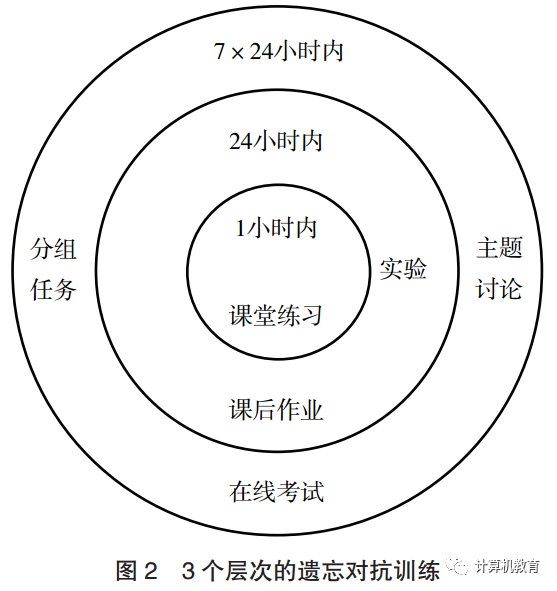
3.4 Combining Knowledge Instruction with Engineering Applications
In teaching the Linux course, the following types of engineering applications can be integrated:
(1) Daily server operations and maintenance, including user management, file management, RPM and YUM, process management, user management, task scheduling, disk partitioning, device mounting, network configuration, and writing maintenance shell scripts using shell commands.
(2) Desktop and web application development, including development of applications in C, C++, Java, Python, etc., installation and customization of integrated development environments, and management of development versions.
(3) Network management, including performing simple network management, network diagnostics, and network security protection using network commands and tools.
(4) Website maintenance, including setting up architectures for large websites and monitoring website status.
In teaching the Linux course, the integration of engineering applications should progress from simple to complex, based on the knowledge points and teaching pace.
(1) For daily server operations, set a group task each week that covers previously taught commands while slightly expanding the depth and breadth of knowledge points. Ultimately, complete a comprehensive operations management task.
(2) For desktop and web application development, use knowledge transfer to migrate applications from object-oriented programming, JavaEE, big data analysis, etc., to the Linux system. Select one application from each category for thematic discussions and group tasks.
(3) For network management, start with typical network faults and security issues, training students’ abilities to analyze and resolve simple network faults and security issues using Linux commands and tools.
(4) For website maintenance, provide students with the source code and database support, allowing them to complete website deployment and status information collection under the Linux system.
3.5 Building a Linux Cloud Experimental Platform
Traditional Linux experimental methods face issues such as fixed time and location, complicated installation and deployment, and difficulty in collecting experimental data. In the construction of the Linux course, we have built a Linux cloud experimental platform based on virtualization technology [11-13], providing students with cloud experimental services anytime and anywhere, offering more opportunities for autonomous experiments. All operations on this platform are completed within assigned virtual machines, ensuring a secure experimental environment and allowing students to save all their experimental data.
On the virtual machine’s software and hardware platform, a Linux experimental management system has been developed with the following functionalities.
(1) Management of teachers and students. The system directly interfaces with the school’s academic management information system, allowing direct access to teacher information, enrolled students, and teaching arrangements.
(2) Distribution of experimental topics. During specified distribution times, experimental topics are sent to all students’ virtual machines.
(3) Submission and grading of experiments. Two methods are used for determining experimental results: the trace determination method for command operation questions, where each command execution leaves a trace in the Linux system that can be inspected to determine completion levels, and the test case method for shell programming questions, where submitted shell scripts are executed under given test cases, and scores are awarded based on execution results.
(4) Score export. The system can export transcripts in formats required by the academic management information system, as well as individual student scores for multiple experiments.
The Linux cloud experimental platform consists of three layers, as shown in Figure 3. Teachers, students, and administrators can connect to the Linux cloud experimental platform via the campus network, supporting various terminals such as tablets, PCs, and smartphones. The platform supports two connection methods: tool connection and web connection. Remote login tools such as PuTTY and PowerShell can be used, while web connections are provided via the platform’s WebSSH.
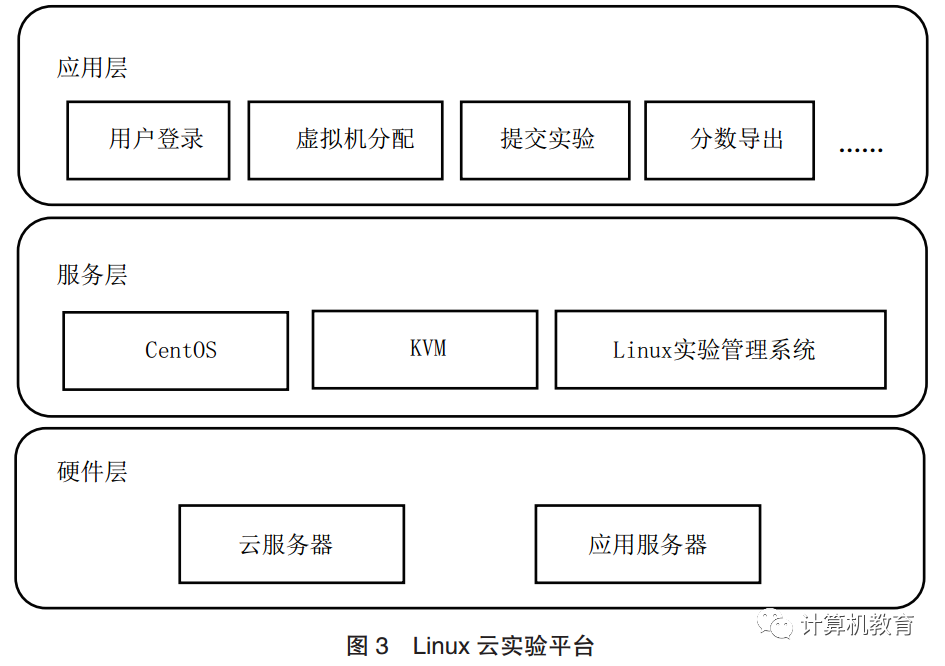
3.6 AI-Driven and Personalized Training
Evaluating the quality of a teaching method is crucial, and for both teachers and students, understanding the factors and behaviors that led to evaluation results is key. This involves constructing an intrinsic connection between learning behaviors and learning outcomes, which is the essence of students’ learning profiles.
With the development of AI technology, big data technology, and online teaching, it has become possible to drive the construction of learning profiles through AI. Using learning profiles allows for the customization of personalized learning plans for students, enabling them to engage in individualized learning based on their learning situations, addressing the issue of personalized instruction [14].
The personalized training plan adopted in the Linux course teaching is shown in Figure 4.
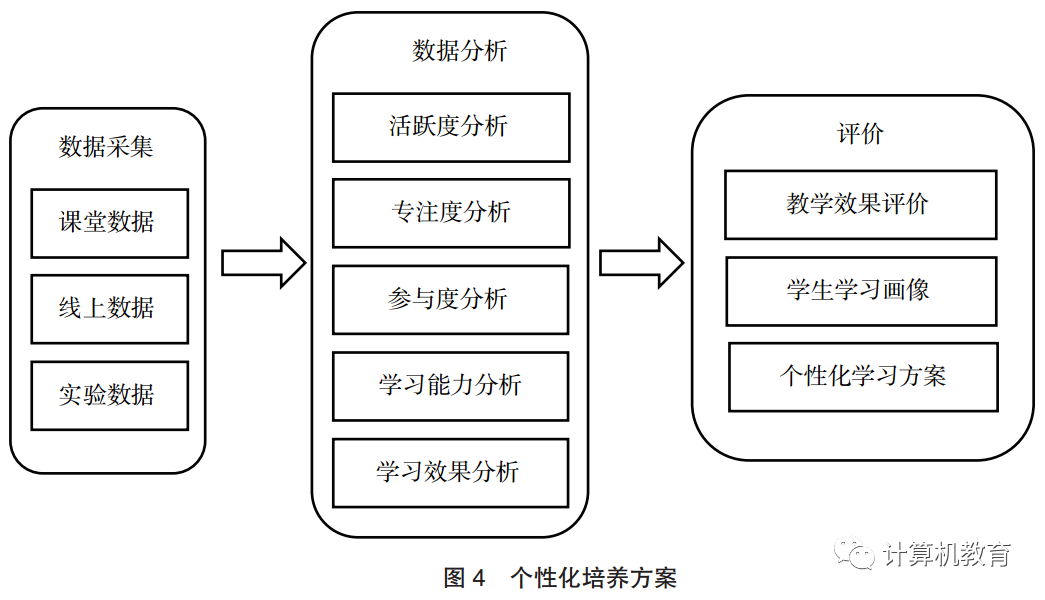
4 Implementation Effects
After implementing the new teaching methods for two years, the results have been significant, with steady improvements in student performance. For comparison, Table 1 shows the performance before and after implementation. In 2019, due to the pandemic, students did not attend school, and remote teaching was implemented, which is not included in the statistics.
After implementing the new teaching methods, the number of students scoring in the high range of 90-100 has significantly increased, while the number of students scoring in the low range of 60-69 has significantly decreased. This indicates that methods such as interest-driven learning, repeated memory, supervised learning, combining online and offline learning, integrating with engineering applications, using cloud experimental platforms, and personalized customization can change students’ learning habits and improve learning efficiency.
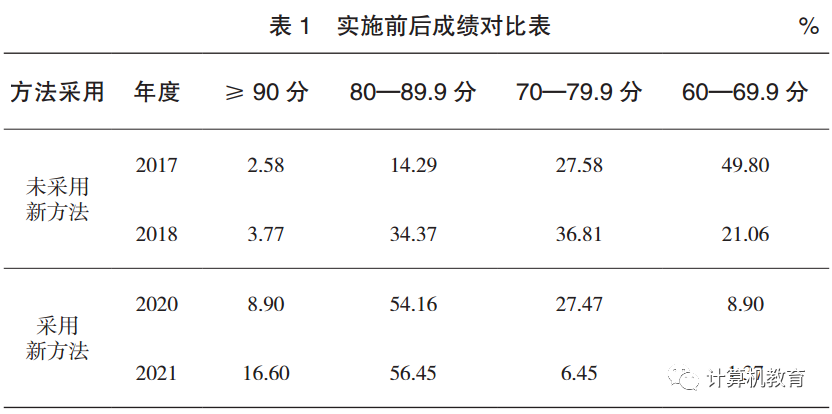
5 Conclusion
The teaching process is not merely a simple knowledge transmission process; it should fully integrate various humanistic, technological, and natural scientific techniques into a multi-layered, multifaceted feedback cycle of teaching, learning, and re-learning. This is the core idea of the Linux course design presented in this paper.
During the implementation of the Linux course design, there are still some issues that need to be further resolved, including methods for cognitive training, aligning with real engineering needs, comprehensive evaluation of experiments and engineering outcomes, and preventing cheating in electronic assignments. Research on these issues will be gradually conducted in the near future.
In future teaching work, we will continuously pay attention to the development of human cognitive science and data analysis, integrating the latest achievements with teaching practice to drive teaching scientifically.
References:
[1] Yan Cairong, Zhu Lihua, Liu Yuqi, et al. Research on Linux System Course Teaching under the Background of New Engineering Education [J]. Computer Education, 2019(6): 152-156.
[2] Ruan Xiaolong, Xu Chenggang, Sun Gaoqiang. Thoughts and Explorations on the Linux Operating System Curriculum System under the New Engineering Concept [J]. Computer Education, 2018(11): 61-64.
[3] Cheng Yuandong. Research on Online Teaching Evaluation Based on Knowledge Point Labels [J]. Higher Education Forum, 2021(4): 23-26.
[4] Xu Jiancheng. Exploration of a Precision Teaching Model Based on Big Data [J]. Basic Education Forum, 2021(12): 109-110.
[5] Wu Chuanrong, Yin Huayi, He Hao, et al. Exploration of the Application of Educational Big Data [J]. Science and Education Guide, 2021(12): 7-9.
[6] Yun Jie, Bai Xue. Research on the Quality Evaluation of Remote Teaching in Computer Networks Driven by Big Data [J]. Modern Electronic Technology, 2021, 44(9): 166-170.
[7] Gao Jie, Fang Hui. Teaching Reform in Nursing Practice Based on Situational Cognitive Learning Theory [J]. Laboratory Science, 2020, 23(6): 137-138, 141.
[8] Wu Yajuan, Wang Yafei, Cao Maojun. Research and Application of a Gagne Cognitive Learning Theory-Based SPOC Teaching Platform [J]. Microcomputer Applications, 2020, 36(4): 14-16, 25.
[9] Wang Lei, Wang Huaguang, Kong Dehui. Insights from Bruner’s Cognitive Learning Theory for Teaching “Soil Mechanics” [J]. Curriculum Education Research, 2019(43): 241-242.
[10] Pan Danrong. Exploring Questioning Strategies in Chinese Language Classrooms Based on Cognitive Learning Theory [J]. New Curriculum Guidance, 2021(9): 23-24.
[11] Li Hongliang, Li Xiang, Cui Haolong, et al. Cloud Computing Technology Experimental Teaching Based on Virtual Simulation Teaching Platforms [J]. Experimental Technology and Management, 2016, 33(11): 125-129.
[12] He Zongming, Chen Guosheng. Design of a Web Teaching Experimental Platform Based on Linux Automatic Virtual Hosts [J]. Software Guide, 2009, 8(8): 91-93.
[13] Liang Zhengping, Shen Xiangjun, Hong Hao. Construction and Exploration of the Linux Innovative Teaching Experimental Center [J]. Experimental Technology and Management, 2011, 28(12): 127-131.
[14] Chen Xuedong, Chen Shushui. Personalized Education: Insights from the Innovative Talent Cultivation of American Universities for Quality Education in China [J]. Journal of Jiangxi Normal University (Philosophy and Social Sciences Edition), 2020, 53(6): 101-108.
Funding Project: 2021 Jilin University Undergraduate Teaching Reform Research Project “Reform of the Online and Offline Blended Teaching Model for UNIX/Linux Operating System Courses” (2021XZD038), “Reform of Industry-Academia Integrated Teaching for Linux Technology Courses” (2021XYB124); 2019 Jilin University Key Project for Experimental Technology “Linux Cloud Experimental Platform” (409020720195).
First Author Introduction: Li Bing, Male, Lecturer at Jilin University, research interests include computer simulation, machine learning, and software engineering, [email protected].
Citation Format:Li Bing, Guo Dong, Kang Jian, et al. Linux Course Design Based on IT New Technologies and Cognitive Science under the Background of New Engineering Education[J]. Computer Education, 2022(4): 159-164.
(Editor: Shi Zhiwei)
More Exciting Content:
[Directory] Computer Education, 2022 Issue 3
[Directory] Computer Education, 2022 Issue 2
[Directory] Computer Education, 2022 Issue 1
[Editorial Board Message] Professor Li Xiaoming from Peking University: Thoughts on the “Year of Classroom Teaching Improvement”…
Professor Chen Daoxu from Nanjing University: Teaching students to ask questions and teaching students to answer questions, which is more important?
[Ten Series]: Trends in Computer Science Development and Their Impact on Computer Education
Professor Li Xiaoming from Peking University: From Interesting Mathematics to Interesting Algorithms to Interesting Programming—A Path for Non-Majors to Experience Computational Thinking?
Reflections on Several Issues in Building a First-Class Computer Discipline
Professor Zhan Dechen from Harbin Institute of Technology Answers 2000 AI Questions
Professor Zhou Aoying, Vice President of East China Normal University: An Interview on Accelerating Computer Science Education and Leading Data Science Education—
New Engineering and Big Data Major Construction
Learning from Others—A Compilation of Research Articles on Computer Education in China and Abroad
